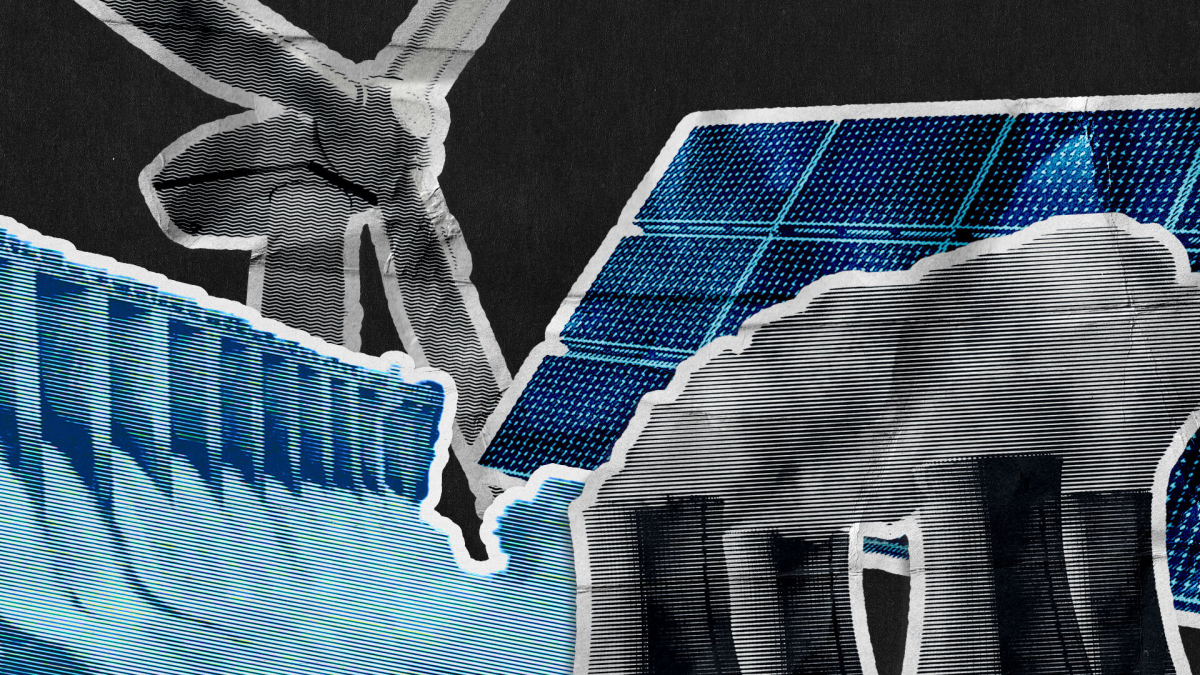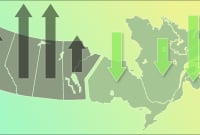Thank you for helping us meet our fundraising goal!
With only a decade left to reach the federal government’s 2035 target for decarbonizing Canada’s electricity sector, some provinces and territories are further ahead and have very different approaches to the challenge.
This map shows how the country generated electricity in 2022 when the most recent data was available. The darker the province or territory, the greater the percentage of its electricity was generated by fossil fuels. This data was compiled by Natural Resources Canada from a variety of sources.
Click on a province or territory to see a more detailed breakdown.
This data does not show the electricity provinces import from other jurisdictions — only what they generated in 2022.
Smaller jurisdictions — such as Nunavut and the Northwest Territories — have a high percentage of fossil fuels on their grids. But because they are sparsely populated their total greenhouse gas emissions arising from electrical generation are still far lower than Ontario and New Brunswick, which have a cleaner mix. Alberta and Saskatchewan's generating methods produce by far the highest amount of emissions.
As widespread electrification of transport, building heat and industry grows, the challenge for provinces and territories is to meet this demand while also decarbonizing their electricity grids by 2035 in line with the forthcoming Clean Electricity Regulations. Details are still being finalized and not all provinces agree with the federal target to have a net-zero electricity grid by 2035.
British Columbia
B.C. is Canada’s second largest producer of hydroelectricity.
The province is typically a net exporter of electricity, primarily to the U.S. — and Alberta, to a lesser degree. However, B.C.’s electricity needs are about to explode as the liquefied natural gas (LNG) industry expands.
B.C. currently has six LNG projects in various stages of development, and if all are built, they will require nearly 70 per cent of B.C.’s total electricity demand in 2022, according to think-tank Clean Energy Canada. This is on top of the increased demand that comes with electrifying other sectors as quickly as possible.
BC Hydro — the province’s largest electricity utility — projects electricity demand could increase by 15 per cent or more by 2030 due to population growth, adoption of technologies such as electric vehicles and heat pumps, and industrial activity such as mining, ports, hydrogen and LNG production. It is not clear how much LNG development is factored into BC Hydro’s scenarios — the utility said that information is confidential and cannot be released.
The Site C dam, currently under construction on the Peace River, is a key part of BC Hydro’s plan to meet this growing demand, along with measures to increase energy efficiency and reduce demand.
B.C. recently put out a call for clean and renewable electricity projects such as wind and solar to add five per cent to its current supply. This will be the first in a series of calls occurring every two years, said BC Hydro spokesperson Kevin Aquino.
Alberta
Alberta is close to phasing out coal-fired electricity entirely — a priority for Canada as a whole because it produces so many emissions – but remains reliant on natural gas plants for most of its electricity, meaning it remains one of the dirtiest grids in the country. Coal-fired electricity generation produces about twice as many emissions as gas-fired.
On May 1, Capital Power retired its second last remaining coal-fired generator and a spokesperson for Utilities Minister Nathan Neudorf said the province expects the utility will retire its — and the province’s — final coal generator this summer, completing Alberta’s coal phase-out six years ahead of the 2030 deadline.
Despite the advances on coal, Alberta is feuding with Ottawa over the Clean Electricity Regulations, which will aim to achieve a non-emitting electricity grid by 2035 and curtail the use of gas-fired generation, with some exceptions.
Capital Power’s Genesee coal plant — consisting of three generators — is being repowered to burn gas and the company recently scrapped a $2.4-billion plan to outfit it with carbon capture technology. In 2022, Genesee produced the equivalent emissions of more than two million gas-powered cars driven for a year.
Alberta’s United Conservative Party has slapped restrictions on the development of renewables such as wind and solar. Premier Danielle Smith says the province will aim for a net-zero grid by 2050: 15 years later than the federal deadline.
In 2035, Alberta will need to generate roughly 70 per cent more electricity than it currently does, according to the CER Energy Futures forecast.
The Alberta Electricity System Operator (AESO) examined two scenarios: a 2050 and 2035 electricity grid decarbonization date. Wind, solar and gas generation with carbon capture utilization and storage (CCUS) technology, are the “dominant” technologies in both scenarios of the AESO forecast. In both, renewable energy peaks at roughly 37 per cent of generation in 2034, but electricity produced from natural gas generating stations outfitted with CCUS will make up the bulk.
The AESO predicts SMRs — small modular nuclear reactors — will be online in 2042. The AESO forecasts electricity generation and capacity, but the final generation mix will be up to the market, because Alberta has a deregulated energy market.
Saskatchewan
Saskatchewan relied on coal-fired power plants for 34 per cent of its electricity in 2022 and is farther behind than Alberta in the phase-out.
Like Alberta, Saskatchewan is aiming to decarbonize its electricity grid by 2050.
SaskPower predicts the province’s electricity demand between 2024 and 2035 will increase by 1.4 per cent per year on average.
To meet demand, SaskPower is increasing new wind and solar, expanding interconnections with neighbouring jurisdictions and exploring emerging technologies such as small modular nuclear reactors and carbon capture technology for natural gas.
SaskPower’s 2024 long-term supply plan emphasizes the role played by grid interties and noted it is seeking contracts to import power from the Southwest Power Pool — the grid for the central United States.
There are three coal plants still operating in Saskatchewan. The Crown corporation will assess converting them to operate on natural gas to extend their lives for a limited period of time.
Two new gas plants are currently being built and extra turbines are being added to two existing gas plants. SaskPower is investigating outfitting gas-fired plants with carbon capture and storage technology as a solution for 2033.
Saskatchewan is the world’s second largest producer of uranium, but currently has no nuclear power. SaskPower is in year three of an eight-year planning phase for its first SMR and with a view to potentially have one online in 2034.
The crown corporation has seven hydroelectric plants in the province, but due to the prairie province’s geography, opportunities to add more are limited.
Like Alberta, Saskatchewan has the sunlight and wind resources to be a renewable energy powerhouse and a hydro-powered neighbour — Manitoba — with which to trade its low cost electricity.
Manitoba
The vast majority of electricity generated by Manitoba is clean hydro power.
However, increasing industry demand, combined with widespread electrification and the adoption of EVs and heat pumps, means the province will need nearly twice as much generating capacity by 2050. Manitoba Premier Wab Kinew wants Manitoba Hydro to work toward a non-emitting grid by 2035, but the province hasn’t yet planned how to achieve this.
As it stands, Manitoba Hydro says wind power and storage and new gas-fired electricity generation will factor significantly in future electricity generation plans. Manitoba Hydro’s plan — which is not based on reaching net-zero greenhouse gas emissions by 2050 — says gas plants are necessary for backup, particularly during winter when electricity demand is highest.
Manitoba Hydro isn’t looking at hydro to bolster electricity capacity due to the high cost of new projects. Upgrades to existing hydro plants are still cost-effective and expected to take place in the coming years.
Ontario
Ontario was the first province to phase out coal-fired electricity under Premier Kathleen Wynne in 2014.
More than half its electricity generation comes from three nuclear power plants: the Bruce, Darlington and Pickering nuclear generating stations. Darlington and Bruce are currently being refurbished to extend their operating lives. Ontario Power Generation (OPG) plans to run the Pickering Generating Station until 2026, at which point it will also need to be refurbished.
Although only nine per cent of Ontario’s electricity was generated at gas plants in 2022, the amount of power generated using gas was greater than Saskatchewan’s total. Last spring, Premier Doug Ford’s government put out a call for projects to build new gas generated plants or expand existing facilities and got a strong response.
The province’s Independent Electricity System Operator’s (IESO) analysis for 2023 shows electricity demand could more than double by 2050. Ontario plans to meet the increased demand primarily by expanding nuclear and hydro generation.
The IESO says gas-fired power plants are needed to “maintain system reliability” until the nuclear plants are refurbished and new non-emitting technologies — such as batteries for energy storage — mature.
Bruce Power plans to add a third power station to its current nuclear operations. Ontario says construction of an SMR capable of powering 300,000 homes at Darlington will be completed in 2028 and the province wants to build three additional SMRs to “meet growing electricity demand in the 2030s.”
Ontario had the most wind and solar generation and capacity of any province in 2022, but the province’s Powering Ontario does not emphasize adding more to the grid. Most mentions of “wind” are to note that it is an intermittent power source of energy and requires storage and natural gas backup.
Ontario is looking to bolster electricity storage and the IESO is currently reviewing two proposed pumped-storage hydroelectricity projects which could help meet future electricity demand. Pumped hydroelectricity can act like a battery by storing water in a reservoir during periods of low demand and running it through turbines to produce electricity when demand is high.
Quebec
Quebec is Canada’s largest electricity producer in Canada, responsible for a third of the country’s total electricity generation in 2022.
Hydro-Quebec — the provincial Crown corporation for electricity generation and distribution — is a major power exporter. The province exports to New England and New York state, and has an exchange agreement with Ontario. However, Quebec’s Energy Minister recently said there isn’t enough electricity to keep pace with industrial demand.
Hydro-Quebec expects the province’s electricity consumption to double by 2050, driven by decarbonizing transport, home heating and industry. To meet demand, the Crown corporation plans to triple wind power generation by 2035, increase the existing hydro generating capacity and build new hydro facilities.
Newfoundland and Labrador
Newfoundland and Labrador is another province with ample hydro resources. Churchill Falls is the province’s biggest hydro asset. There are also a handful of gas generation plants, almost two dozen remote diesel plants and the Holyrood oil-fired plant.
Newfoundland and Labrador Hydro — a provincial Crown corporation that generates and delivers electricity in Labrador — projects a 13 per cent increase in electricity supply in the next decade. Later this spring, NL Hydro will submit a more detailed plan to the regulator, but two solutions are currently on the table: The possible addition of another hydroelectric unit at its existing Bay D'Espoir facility, located on the south coast of Newfoundland, and a proposed new diesel generator for peak demand periods and emergency back-up.
The Holyrood Thermal Generating Station was supposed to be phased out once the Muskrat Falls hydroelectric facility and transmission came online, but the costly hydroelectric project was delayed and plagued with technical problems and repairs, so Holyrood is still part of the generating fleet to provide back up.
New Brunswick
New Brunswick is the only other province besides Ontario with nuclear generation: the Point Lepreau Nuclear Generating Station, which generated 28 per cent of the province’s electricity in 2022.
Belledune Generating Station is the province’s last coal-fired power plant. The government and New Brunswick Power intend to operate it until the 2030 coal phaseout deadline. The likeliest course of action is to switch its fuel to biomass or renewable natural gas to operate beyond 2030. A final decision on Belledune will be made this year. The large, oil-fired Coleson Cove Generating Station is slated for retirement in 2040.
NB Power plans to extend the life of two of its diesel generators past 2030 and one natural gas generator — with the potential to extend a second gas generator.
The province anticipates an estimated 60 per cent increase in electricity demand from now to 2035, largely driven by industrial demands, and wants the utility to fill that gap with SMRs and wind power.
Last fall, Nova Scotia and New Brunswick agreed to upgrade and expand an existing transmission line between the two provinces, rather than pursue the Atlantic Loop — a costly energy transmission circuit that would connect Atlantic provinces with hydropower from Quebec, and possibly Labrador, to help decarbonize their electricity supply.
SMRs are a “critical part” of the province’s electricity future, according to NB Power. All the utility’s scenarios include two SMRs (from companies Moltex Energy and ARC Clean Technology) coming online between 2030 and 2040.
Nova Scotia
A large share of Nova Scotia’s generation relies on coal, but the province remains committed to phasing it out before the 2030 deadline.
Last summer, Nova Scotia Power announced plans to convert three coal-fired units at its Lingan Generating Station to heavy fuel oil in 2030 and keep them open as a backup power source for two more decades.
Nova Scotia has excellent wind resources which are also currently the cheapest source of available electricity. Wind will play the biggest role, by far, in the province’s electricity mix going forward. By the end of the decade, the government aims to add new onshore wind, quintuple the amount of solar and bring batteries online to increase storage capacity.
On top of its own hydroelectric generation, Nova Scotia imports electricity from Muskrat Falls in Newfoundland and Labrador.
The planned expansion of transmission lines between Nova Scotia and New Brunswick are another key pillar of the province’s plan to have an 80 per cent non-emitting grid by 2030.
Prince Edward Island
PEI’s electricity generation is overwhelmingly from renewable sources. However, that only comprises about 20 per cent of the electricity it uses. Nearly 70 per cent of the Island’s electricity is imported from New Brunswick.
The tiny maritime province is expected to release an updated energy strategy this year and does not currently have any projections for future energy demand or actions to fill the gap. It remains to be seen how much electricity PEI will strive to produce on the island and how much it will continue to rely on imports.
Yukon
Yukon’s main territorial electricity grid runs predominantly on hydro with some help from diesel and LNG power plants — with the exception of five off-grid communities that rely on diesel generation, according to the federal government.
Yukon’s hydroelectricity comes from four generating stations, the largest of which is the Whitehorse Hydro Plant.
The territory has a surplus of renewable electricity in the summer when demand is lowest and hydroelectric generation is at its highest. In the winter, at a time when hydroelectric generating capacity is reduced by lower water levels, electricity demand is two to three times higher. Because of this, solar isn’t the best fit — wind, hydro and pumped hydro storage are better options to bolster electricity generation in the winter months.
Yukon Energy Corporation is working on a 10-year renewable electricity supply plan, expected to be released this summer, that will propose how to meet electricity needs and reduce reliance on diesel generators in the winter.
If a lot of climate policies and renewable projects are implemented and the carbon price remains in place, twice the existing generation capacity could be required by 2035, according to a Navius research report. The Government of Yukon Energy branch noted these forecasts can vary wildly from year to year if new industrial projects come online.
A project that would see YEC buy electricity from a proposed hydroelectric plant in Atlin, B.C., is a key pillar of Yukon’s plans to bolster electricity supply in the winters, but a funding shortfall has the project stuck in limbo.
Northwest Territories
The Northwest Territories electricity system is completely disconnected from the North American electricity system. In the south, there are two isolated grids, both fed by hydropower, that serve eight communities, with diesel generators available for backup during peak demand or low-water years. The other 25 communities have their own diesel or natural gas generation stations.
Getting these remote communities off fossil-fueled generation is tricky. The best option is to build transmission lines to connect communities to hydropower but the infrastructure is costly.
Despite the challenges, the territory aims to reduce GHG emissions from electricity generation in diesel communities by 25 per cent by the end of the decade.
The Government of the Northwest Territories (GNWT) is advancing the Taltson Hydro Expansion Project which would increase hydro capacity and connect three additional communities to the two existing hydroelectric grids. The project, expected to be online in 2033, would provide clean electricity to more than 70 per cent of the population.
The GNWT also plans to construct transmission lines to connect more communities to hydroelectric power in the South and North Slave regions before 2030.
The Northwest Territories Power Corporation does not forecast a significant increase in electricity demand in 2035, but that could change if new mines open in the region.
Right now, the government doesn’t have any plans or electricity forecast past 2030, but an independent report by Navius research predicts a business-as usual-scenario will see roughly 70 per cent more electricity generated in 2050.
Nunavut
Nunavut is the largest of Canada’s 13 provinces and territories and has the smallest population. There is no shared electricity grid; 99 per cent of Nunavut’s electricity was generated at community-based diesel plants in 2022. There is a project in the works for an intertie to link northern Manitoba to communities in Nunavut so they can tap into the prairie province’s clean power. To date, the federal government has announced over $35 million to advance the Kivalliq Hydro-Fibre Link project, which would get five communities and two mines off diesel when complete.
Qulliq Energy Corporation (QEC) — a territorial utility in charge of electricity — only forecasts electricity needs up to 2030 and expects only a small increase, however, this will change if there are any major developments in communities.
QEC’s main approach is upgrading diesel generating capacity while Independent Power Producers bring more renewable electricity online.






Comments
So the Ontario's IESO says they can't use batteries for energy storage until the technology matures. 43 GWhs of battery energy storage systems (BESS) were installed in 2022. The growth in BESS installations is expected to increase annually from 2022 to 2030. Zero SMRs were installed in 2022 and none are likely to be installed prior to 2030. The IESO seems to have inconsistent metrics for maturity.
Ontario deniers need to have a conversation -- better yet, conduct higher quality research -- with Australia, California and the UK where batteries play a huge role. To say battery tech isn't "mature enough" flies in the face of the huge success of batteries in these jurisdictions.
Nova Scotia just adopted a plan, New Brunswick getting close. Just Alberta and Saskatchewan holding out. Technological innovations are happening so fast it may be hard to get the Electricity Generation Providers on board
Nova Scotia, Saskatchewan and Alberta are the only big users of Fossil fuels. NS recently adopted a transition p,an to renewable. Alberta and Saskatchewan and their radical right governments seem to think the world isn't changing and are doing a disservice to their citizens by not only resisting change but actively passing legislation prohibiting it, in energy as well as other social areas. Leadership totally lacking